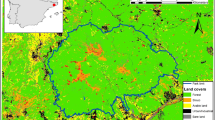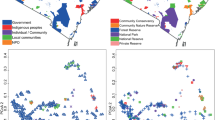Abstract
Various jurisdictions in Canada are currently undertaking, or have recently completed, planning exercises as part of implementation and expansion of representative reserve networks (networks of provincial parks, national parks, ecological reserves, etc.). These exercises have resulted in recommendations to governments about which areas of land should be set aside as protected areas, and different levels of government have been involved in the process of land acquisition. In some cases, planning exercises have included implementation of new protected areas to complement existing reserve networks. Many of these exercises have applied principles such as complementarity, using heuristic algorithms that are well-described in the literature. These planning exercises may be conducted within politically or ecologically bounded target regions of varying extents. Here, I develop candidate locations for representative reserve areas for disturbance-sensitive mammals across Canada. I use ecologically bounded regions (within the national boundaries of Canada) at three different levels of spatial hierarchy: mammal provinces, ecozones, and ecoregions. I show that the extent of the target region has an effect on the minimum number of protected areas required to achieve representation; a larger region requires fewer protected areas than the sum of the protected areas required to represent its component regions at a lower level of spatial hierarchy. The results illustrate that selection of sites for inclusion in a reserve network is highly scale-dependent, and different spatial extents in the target regions may introduce inefficiencies or redundancies in selecting representative protected areas.






Similar content being viewed by others
References
Bailey RG (1989) Explanatory supplement to ecoregions map of the continents. Environ Conserv 16:307–309 [with separate map at 1: 30,000,000]
Cowling RM, Pressey RL, Rouget M, Lombard AT (2003a) A conservation plan for a global biodiversity hotspot—the Cape Floristic Region, South Africa. Biol Conserv 112:191–216
Cowling RM, Pressey RL, Sims-Castley R, le Roux A, Baard E, Burgers CJ, Palmer G (2003b) The expert or the algorithm?—Comparison of priority conservation areas in the cape floristic region identified by park managers and reserve selection software. Biol Conserv 112:147–167
Danby RK, Slocombe DS (2005) Region ecology, ecosystem geography, and transboundary protected areas in the St. Elias Mountains. Ecol Appl 15:405–422
Ecological Stratification Working Group (1996) A national ecological framework for Canada. Ottawa: Agriculture and Agri-Food Canada, Research Branch, Centre for Land and Biological Resources Research; and Ottawa: Environment Canada, State of the Environment Directorate, Ecozone Analysis Branch
Erasmus BFN, Freitag S, Gaston KJ, Erasmus BH, van Jaarsveld AS (1999) Scale and conservation planning in the real world. Proc R Soc Lond Ser B 266:315–319
Glenn SM (1990) Regional analysis of mammal distributions among Canadian parks—implication for park planning. Can J Zool 68:2457–2464
Glenn SM, Nudds TD (1989) Insular biogeography of mammals in Canadian parks. J Biogeogr 16:261–268
Gurd DB, Nudds TD (1999) Insular biogeography of mammals in Canadian parks: a re-analysis. J Biogeogr 26:973–982
Gurd DB, Nudds TD, Rivard DH (2001) Conservation of mammals in eastern North American wildlife reserves: how small is too small? Conserv Biol 15:1355–1363
Hagmeier EM (1966) A numerical analysis of the distributional patterns of North American mammals II. Re-evaluation of the provinces. Syst Zool 15:279–299
Haila Y (2002) Scaling environmental issues: problems and paradoxes. Landsc Urban Plan 61:59–69
Humphreys WF, Kitchener DJ (1982) The effect of habitat utilization on species-area curves: implications for optimal reserve area. J Biogeogr 9:391–396
Jongman RHG (1995) Nature conservation planning in Europe: developing ecological networks. Landsc Urban Plan 32:169–183
Kerley GIH, Pressey RL, Cowling RM, Boshoff AF, Sims-Castley R (2003) Options for the conservation of large and medium-sized mammals in the Cape Floristic Region hotspot, South Africa. Biol Conserv 112:169–190
Kunin WE (1997) Sample shape, spatial scale and species counts: implications for reserve design. Biol Conserv 82:369–377
Lunney D, Pressey B, Archer M, Hand S, Godthelp H, Curtin A (1997) Integrating ecology and economics: illustrating the need to resolve the conflicts of space and time. Ecol Econ 23:135–143
Margules CR, Nicholls AO, Pressey RL (1988) Selecting networks of reserves to maximize biological diversity. Biol Conserv 43:63–76
Margules CR, Pressey RL, Williams PH (2002) Representing biodiversity: data and procedures for identifying priority areas for conservation. J Biosci 27:309–326
McDonald R, McKnight M, Weiss D, Selig E, O’Connor M, Violin C, Moody A (2005) Species compositional similarity and ecoregions: do ecoregion boundaries represent zones of high species turnover? Biol Conserv 126:24–40
Noss RF, Carroll C, Vance-Borland K, Wuerthner G (2002) A multicriteria assessment of the irreplaceability and vulnerability of sites in the Greater Yellowstone Ecosystem. Conserv Biol 16:895–908
O’Neill RV, DeAngelis DL, Waide JB, Allen TFH (1986) A hierarchical concept of ecosystems. Princeton University Press, Princeton
Oswald ET, Senyk JP (1977) Ecoregions of the Yukon Territory. Publication BC-X-164, Canadian forest service. Environment Canada, Victoria, British Columbia
PARKS CANADA (1997) National parks system plan. Parks Canada, Ottawa, ON
Patterson BD, Ceballos G, Sechrest W, Tognelli MF, Brooks T, Luna L, Ortega P, Salazar I, Young BE (2003) Digital distribution maps of the mammals of the Western Hemisphere, Version 1.0. NatureServe, Arlington, VA, USA
Pressey RL, Nicholls AO (1989) Application of a numerical algorithm to the selection of reserves in semi-arid New South Wales. Biol Conserv 50:263–278
Pressey RL, Humphries CJ, Margules CR, Van-Wright RI, Williams PH (1993) Beyond opportunism: key principles for systematic reserve selection. Trends Ecol Evol 8:124–128
Pressey RL, Johnson IR, Wilson PD (1994) Shades of irreplaceability—towards a measure of the contribution of sites to a reservation goal. Biodivers Conserv 3:242–262
Pressey RL, Watts ME, Barrett TW (2004) Is maximizing protection the same as minimizing loss? Efficiency and retention as alternative measures of the effectiveness of proposed reserves. Ecol Lett 7:1035–1046
Purchase D (2003) The Northwest Territories protected areas strategy: background. In: Wiersma YF (ed) Designing protected areas: wild places for wildlife: proceedings summary of the 2003 Canadian Council on Ecological Areas (CCEA) and Circumpolar Protected Areas Network (CPAN) Workshop. Canadian Council on Ecological Areas, Ottawa, ON, Canada, pp 52–55
Rodrigues ASL, Gaston KJ (2002) Rarity and conservation planning across geopolitical units. Conserv Biol 16:674–682
Rouget M (2003) Measuring conservation value at fine and broad scales: implications for a diverse and fragmented region, the Agulhas Plain. Biol Conserv 112:217–232
Saunders DA, Briggs SV (2002) Nature grows in straight lines—or does she? What are the consequences of the mismatch between human-imposed linear boundaries and ecosystem boundaries? An Australian example. Landsc Urban Plan 61:71–82
Stoms DM, Chomitz KM, Davis FW (2004) TAMARIN: a landscape framework for evaluating economic incentives for rainforest restoration. Landsc Urban Plan 68:95–108
Tress B, Tress G, Fry G, Opdam P (2006) (eds) From landscape research to landscape planning: aspects of integration, education and application. Springer, Dordrecht, the Netherlands
Turner MG, Gardner RH, O’Neill RV (2001) Landscape ecology in theory and practice. Springer-Verlag, New York, USA
Urban DL, O’Neill RV, Shugart HH (1987) A hierarchical perspective can help scientists understand spatial patterns. Bioscience 37:119–127
Warman LD, Forsyth DM, Sinclair ARE, Freemark K, Moore HD, Barrett TW, Pressey RL, White D (2004) Species distributions, surrogacy, and important conservation regions in Canada. Ecol Lett 7:374–379
Wiens JA (1989) Spatial scaling in ecology. Funct Ecol 3:385–397
Wiersma YF, Nudds TD (2004) On the fraction of land needed for protected areas. In: Munro NWP, Dearden P, Herman TB, Beazly K, Bondrup-Nielson S (eds) Making ecosystem based management work: connecting managers and researchers. Proceedings of the Fifth International Conference on Science and Management of Protected Areas, Chap. 7, CD-ROM proceedings. Wolfville, NS, Canada
Wiersma YF, Nudds TD (2006) Conservation targets for viable species assemblages: data independent targets are not appropriate. Biodivers Conserv 15:4555–4567
Wiersma YF, Urban DL (2005) Beta diversity and nature reserve system design: a case study from the Yukon. Conserv Biol 19:1262–1272
Wu J (1999) Hierarchy and scaling: extrapolating information along a scaling ladder. Can J Remote Sens 25:367–380
Wu J, Hobbs R (2002) Key issues and research priorities in landscape ecology: an idiosyncratic synthesis. Landsc Ecol 17:355–365
Wu J, Li H (2006) Concepts of scale and scaling. In: Wu J, Jones KB, Li H, Loucks OL (eds) Scaling and uncertainty analysis in ecology: methods and applications. Springer, New York, pp 52–55
Wu J, Jones KB, Li H, Loucks OL (2006) (eds) Scaling and uncertainty analysis in ecology: methods and applications. Springer, New York
YPAS (Yukon Protected Areas Strategy) (1998) Types of protected areas and criteria for selection. Technical Paper No. 2. Department of Renewable Resources, Yukon Government, Canada
Acknowledgments
YFW was supported by an Ontario Graduate Scholarship and a grant from the Canadian Council on Ecological Areas. Mammal data was provided by NatureServe in collaboration with Bruce Patterson, Wes Sechrest, Marcelo Tognelli, Gerardo Ceballos, The Nature Conservancy—Migratory Bird Program, Conservation International—CABS, World Wildlife Fund—US, and Environment Canada—WILDSPACE. Thanks to D. Sleep, T. D. Nudds, R. L. Pressey, J. Wu, and two anonymous reviewers for helpful comments on an earlier draft of the manuscript and to K. Lindsay for originally proposing the research idea. Additional research support was provided by grants from NSERC and Parks Canada to TDN.
Author information
Authors and Affiliations
Corresponding author
Rights and permissions
About this article
Cite this article
Wiersma, Y.F. The effect of target extent on the location of optimal protected areas networks in Canada. Landscape Ecol 22, 1477–1487 (2007). https://doi.org/10.1007/s10980-007-9126-2
Received:
Accepted:
Published:
Issue Date:
DOI: https://doi.org/10.1007/s10980-007-9126-2




